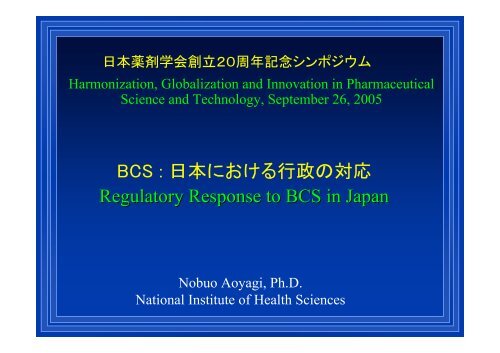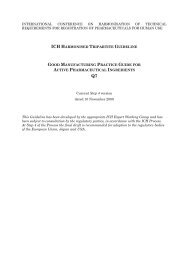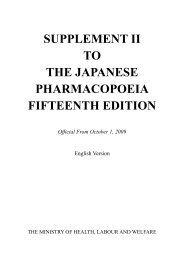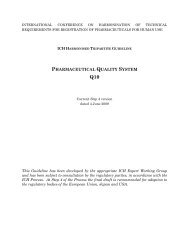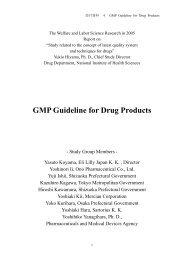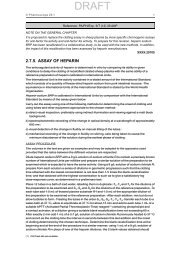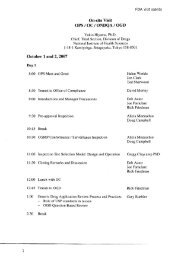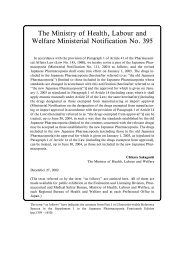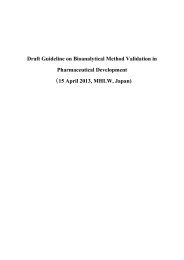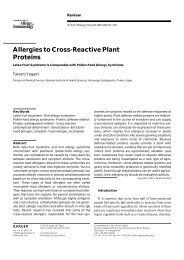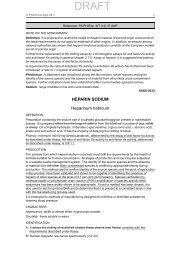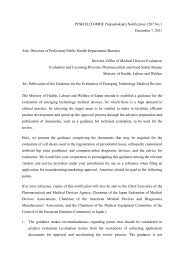Regulatory Response to BCS in Japan BCS : æ¥æ¬ã«ããã ... - NIHS
Regulatory Response to BCS in Japan BCS : æ¥æ¬ã«ããã ... - NIHS
Regulatory Response to BCS in Japan BCS : æ¥æ¬ã«ããã ... - NIHS
Create successful ePaper yourself
Turn your PDF publications into a flip-book with our unique Google optimized e-Paper software.
Harmonization, Globalization and Innovation <strong>in</strong> Pharmaceutical<br />
Science and Technology, September 26, 2005<br />
<br />
<strong>Regula<strong>to</strong>ry</strong> <strong>Response</strong> <strong>to</strong> <strong>BCS</strong> <strong>in</strong> <strong>Japan</strong><br />
Nobuo Aoyagi, Ph.D.<br />
National Institute of Health Sciences
In pharmaceutical regulation, it is<br />
important <strong>to</strong> reduce burdensome tests<br />
while efficacy and safety are ensured<br />
maximally.<br />
In bioequivalence (BE) tests, human<br />
tests should be reduced as much as<br />
possible where dissolution test may be<br />
used as a surrogate. But…
Flufenamic acid<br />
capsule<br />
Kaniwa,<br />
Int.J.Cl.Pharm.Ter.Tox.,<br />
21, 56, 1983<br />
% dissolved<br />
% dissolved<br />
Paddle at 120 rpm<br />
100<br />
80<br />
60<br />
40<br />
20<br />
0<br />
80<br />
60<br />
40<br />
20<br />
A<br />
B<br />
C<br />
D<br />
0 60 120 180<br />
Time (h)<br />
pH 7.6<br />
Indomethac<strong>in</strong><br />
100<br />
capsule pH 7.2<br />
Concentration (ug/ml)<br />
Serum concentration<br />
Concentration (ug/ml)<br />
10<br />
2.5<br />
2.0<br />
1.5<br />
1.0<br />
0.5<br />
8<br />
6<br />
4<br />
2<br />
0<br />
0 2 4 6 8<br />
Time (h)<br />
Capsule C<br />
Capsule D<br />
Capsule A<br />
Capsule B<br />
Aoyagi, Int.J.Cl.Pharm.Ter.Tox.,<br />
23, 529, 1985<br />
0<br />
0 30 60<br />
Time (m<strong>in</strong>)<br />
0.0<br />
0 2 4 6 8<br />
Time (h)
Outl<strong>in</strong>e<br />
• Concept of <strong>BCS</strong><br />
• BE Test <strong>in</strong> <strong>Japan</strong><br />
• Reason for Not us<strong>in</strong>g <strong>BCS</strong><br />
• Conclusion
Unreliable <strong>in</strong> vitro/<strong>in</strong> vivo correlation (IVIVC)<br />
Limit the use of dissolution test as a surrogate for<br />
human test <strong>in</strong> BA/BE studies<br />
Other approaches are needed<br />
without rely<strong>in</strong>g on IVIVC alone<br />
Mechanistic analysis of drug absorption
Biopharmaceutics Classification System (<strong>BCS</strong>)<br />
Permeability<br />
Low High<br />
High<br />
Class 1<br />
High solubility (HS)<br />
High permeability (HP)<br />
Class 3<br />
Solubility<br />
High solubility (HS)<br />
Low permeability (LP)<br />
Low<br />
Class 2<br />
Low solubility (LS)<br />
High permeability (HP)<br />
Class 4<br />
Low solubility (LS)<br />
Low permeability (LP)<br />
HS : Highest dose is soluble <strong>in</strong>
Rate limit<strong>in</strong>g step <strong>in</strong> gastro<strong>in</strong>test<strong>in</strong>al (GI) absorption<br />
<strong>BCS</strong> GI absorption IVIVC<br />
Class 1<br />
Gastric empty<strong>in</strong>g-limited<br />
Not expected<br />
(HS / HP)<br />
if dissolution is rapid<br />
Class 2<br />
Dissolution-limited Expected<br />
(LS / HP)<br />
Class 3<br />
(HS / LP)<br />
Class 4<br />
(LS / LP)<br />
Permeability-limited Not expected<br />
Dissolution or ?<br />
permeability-limited<br />
IVIVC : <strong>in</strong> vitro/<strong>in</strong> vivo correlation
Great Contribution of <strong>BCS</strong> <strong>in</strong><br />
Pharmaceutical Regulation<br />
• Enable the use of dissolution test for<br />
Biowaiver of m<strong>in</strong>or change <strong>in</strong><br />
formulation & manufactur<strong>in</strong>g <strong>in</strong> U.S.A.<br />
• Currently be<strong>in</strong>g used for biowaiver of<br />
multi-source products <strong>in</strong> WHO Guidel<strong>in</strong>e
C<strong>in</strong>nariz<strong>in</strong>e<br />
capsules<br />
Ogata, Int.J.Pharm.<br />
29, 113, 1986<br />
Concentration (ng/ml)<br />
100<br />
80<br />
60<br />
40<br />
20<br />
Normal subject<br />
B<br />
C<br />
Concentration (ng/ml)<br />
100<br />
80<br />
60<br />
40<br />
20<br />
Achlorhydric<br />
subject<br />
B<br />
C<br />
0<br />
0 2 4 6 8<br />
Time (h)<br />
0<br />
0 2 4 6 8<br />
Time (h)<br />
Achlorhydria (%)<br />
80<br />
60<br />
40<br />
20<br />
0<br />
10 20 30 40 50 60 70<br />
Age (year)<br />
Achlorhydric subject (%) <strong>in</strong><br />
each age category<br />
Morihara, Biol.Pharm.Bull., 24, 313,2001
• BE test for whom and <strong>in</strong> whom ?<br />
• How <strong>to</strong> assure BE <strong>in</strong> normal and achorhydric<br />
subjects? Can we require BE tests <strong>in</strong> both groups?<br />
• Is dissolution test<strong>in</strong>g truly of no use for BE<br />
assessment ?<br />
Need <strong>to</strong> clarify why <strong>in</strong> vitro/<strong>in</strong> vivo<br />
correlations are unreliable
In Vivo : Dynamic<br />
In Vitro : Static<br />
pH 1.2 - 7.6<br />
Fluid volume 5 - 200 ml<br />
pH 3.1- 6.7<br />
Contraction<br />
To predict <strong>in</strong> vivo performance, dissolution test<br />
must be done under various conditions (different<br />
pH, ionic strength, agitation etc).<br />
Not suitable for BE test<br />
Is there simpler approach ?<br />
Based on current understand<strong>in</strong>g of GI physiology<br />
and learned knowledge, discrim<strong>in</strong>ative<br />
dissolution tests should be established that are<br />
able <strong>to</strong> discrim<strong>in</strong>ate Bio<strong>in</strong>equivalent products.<br />
What is the discrim<strong>in</strong>ative dissolution tests ?
Discrim<strong>in</strong>ative dissolution test<br />
IR products<br />
No dose-dump<strong>in</strong>g<br />
• Low mechanical stress (e.g. Paddle method)<br />
• Low agitation (e.g. 50 rpm)<br />
• Multiple pHs <strong>in</strong> a physiological pH range<br />
• No surfactant<br />
especially under vigorous conditions<br />
CR products<br />
Dose-dump<strong>in</strong>g<br />
• Low and high mechanical stress (Paddle and<br />
Dis<strong>in</strong>tegration apparatus)<br />
• Low and high agitation (50 and 200 rpm)<br />
• Multiple pHs <strong>in</strong> a physiological pH range<br />
• Low and high concentrations of surfactant<br />
• Low and high ionic strength
Paddle method<br />
Dissolution Test for IR products<br />
Acidic drug Basic drug Coated product<br />
Neutral drug<br />
50 rpm pH 1.2 pH 1.2 pH 1.2<br />
pH 5.5-6.5 pH 3.0-5.0 pH 3.0-5.0<br />
pH 6.8-7.5 pH 6.8 pH 6.8<br />
Water Water Water<br />
100 rpm A discrim<strong>in</strong>ative pH between pH 1.2 – 7.5
Paddle, 50 rpm<br />
100<br />
Predicted Level<br />
0.8<br />
80<br />
60<br />
40<br />
20<br />
pH 1<br />
Convolution<br />
0.6<br />
0.4<br />
0.2<br />
A<br />
B<br />
0<br />
0.0<br />
100<br />
0.8<br />
80<br />
60<br />
40<br />
20<br />
pH 4<br />
0.6<br />
0.4<br />
0.2<br />
A<br />
B<br />
0<br />
0.0<br />
% dissolved<br />
100<br />
80<br />
60<br />
40<br />
20<br />
0<br />
pH 7<br />
0 20 40 60<br />
Concentration (ug/ml)<br />
0.8<br />
0.6<br />
0.4<br />
0.2<br />
0.0<br />
A<br />
B<br />
0 2 4 6<br />
Time (m<strong>in</strong>)<br />
Time (h)
Similar dissolution at all pHs by<br />
discrim<strong>in</strong>ative <strong>in</strong> vitro tests<br />
Likely bioequivalent without<br />
subject-formulation <strong>in</strong>teraction<br />
No need of strict human study<br />
(decrease of sample size or waiver of<br />
human study)
Different dissolutions under one<br />
of conditions<br />
They may not be bio-<strong>in</strong>equivalent<br />
<strong>in</strong>equivalent<br />
<strong>in</strong> some types of subjects<br />
Strict human study us<strong>in</strong>g discrim<strong>in</strong>ative<br />
subjects such as achlorhydric subject
100<br />
80<br />
60<br />
40<br />
20<br />
0<br />
Dissolution Predicted Observed<br />
pH 1<br />
0 20 40 60<br />
.<br />
.<br />
A<br />
E<br />
Convolution<br />
7<br />
6<br />
5<br />
4<br />
3<br />
2<br />
1<br />
0<br />
0 5 10 15 20 25<br />
7<br />
6<br />
5<br />
4<br />
3<br />
2<br />
1<br />
Normal<br />
subjects<br />
0<br />
0 5 10 15 20 25<br />
% dissolved<br />
100<br />
80<br />
60<br />
40<br />
20<br />
0<br />
0 20 40 60<br />
Time (m<strong>in</strong>)<br />
pH 7<br />
Metronidazole Tablets<br />
Concentration (ug/ml)<br />
7<br />
6<br />
5<br />
4<br />
3<br />
2<br />
1<br />
0<br />
0 5 10 15 20 25<br />
Time (h)<br />
Concentration (ug/ml)<br />
7<br />
6<br />
5<br />
4<br />
3<br />
2<br />
1<br />
0<br />
Achlorhydric<br />
subjects<br />
0 5 10 15 20 25<br />
Time (h)<br />
Ogata. Int.J.Pharm.Ther.Tox.<br />
23, 277, 1985.
Use of Dissolution Test <strong>in</strong> BE Assessment<br />
1. Generic drug<br />
• Exemption from 90 % confidence <strong>in</strong>terval (C.I.)<br />
If dissolutions are similar, test products will be<br />
approved even if 90 % C.I. of Cmax or AUC is<br />
out of 80 - 125 %.<br />
• Strict human test us<strong>in</strong>g specific subjects<br />
If dissolutions differ at pH 6.8, achlorhydric<br />
subjects are required <strong>in</strong> human test.<br />
2. M<strong>in</strong>or change <strong>in</strong> formulation and different strengths<br />
If dissolutions are similar, , human test can be<br />
exempted for all drugs.
<strong>BCS</strong> was not <strong>in</strong>troduced <strong>in</strong> our BE tests, although<br />
we discussed its advantage and disadvantage.<br />
Why ?<br />
The reason will be shown <strong>in</strong> follow<strong>in</strong>g slides.
Bioavailability<br />
Same<br />
Bioavailability<br />
Dissolution <strong>in</strong><br />
digestive tract<br />
Same<br />
Dissolution <strong>in</strong><br />
digestive tract<br />
Formulation<br />
Manufactur<strong>in</strong>g<br />
Reference product<br />
Identical<br />
Formulation<br />
Manufactur<strong>in</strong>g<br />
Test product
Bioavailability<br />
Differ<br />
Bioavailability<br />
Dissolution <strong>in</strong><br />
digestive tract<br />
Differ<br />
Dissolution <strong>in</strong><br />
digestive tract<br />
Formulation<br />
Manufactur<strong>in</strong>g<br />
Reference product<br />
Differ<br />
Formulation<br />
Manufactur<strong>in</strong>g<br />
Test product<br />
Solubility and permeability are not directly related<br />
<strong>to</strong> difference <strong>in</strong> BA
Reason 1<br />
Solubility and permeability are not<br />
immediate causes for Bio<strong>in</strong>equivalence<br />
which is ma<strong>in</strong>ly caused by differences <strong>in</strong><br />
formulation & manufactur<strong>in</strong>g.
Reason 2<br />
In U.S.A., <strong>BCS</strong> is employed <strong>to</strong> <strong>in</strong>crease the use<br />
of dissolution test for Biowaiver <strong>in</strong> m<strong>in</strong>or change<br />
<strong>in</strong> formulation & manufactur<strong>in</strong>g while it will<br />
decrease the use <strong>in</strong> <strong>Japan</strong>, if <strong>in</strong>troduced, where<br />
multimedia dissolution tests are extensively<br />
applied (<strong>BCS</strong> does not give merits).<br />
BE can be assured by the<br />
multimedia test without rely<strong>in</strong>g<br />
on <strong>BCS</strong>?<br />
BE of most IR products will be assured
• Strict requirement us<strong>in</strong>g specific subjects<br />
if dissolutions differ<br />
• Waiver of 90 % confidence <strong>in</strong>terval<br />
if dissolutions are similar<br />
Consequently compel<br />
To produce generic products show<strong>in</strong>g<br />
comparable <strong>in</strong> vitro dissolutions<br />
Most generic companies<br />
have enough capability<br />
Accumulation of <strong>in</strong> vitro and <strong>in</strong> vivo data <strong>in</strong> generic<br />
companies (1997-2005)
Questionaire Survey <strong>to</strong> Generic Companies (n=14)<br />
March, 2005<br />
Q : All your products,<br />
show<strong>in</strong>g similar dissolution,<br />
passed human BE test ?<br />
Failed<br />
(27 %)<br />
Question <strong>to</strong> failed<br />
companies<br />
Q : Percentage of<br />
failed products / <strong>to</strong>tal<br />
Passed<br />
(73 %)<br />
< 5 %<br />
(All companies)<br />
Failure ratio of human BE test < 1.4 % (= 27 × 5 %)
Multimedia dissolution tests used <strong>in</strong><br />
<strong>Japan</strong> function well <strong>to</strong> ensure BE even<br />
for generic IR products which differ from<br />
<strong>in</strong>nova<strong>to</strong>r products <strong>in</strong> formulation and<br />
manufactur<strong>in</strong>g.
Test Medium of Dissolution tests for M<strong>in</strong>or Changes<br />
<strong>in</strong> Excipients (Level 2 <strong>in</strong> USA = Level C <strong>in</strong> <strong>Japan</strong>)<br />
U.S.A.<br />
<strong>Japan</strong><br />
<strong>BCS</strong><br />
For all drugs<br />
Class 1 : 0.1N HCl Multi-media ( pH 1.2,<br />
Class 2 : Compendial medium pH 3-6, pH6.8, Water)<br />
Class 3 : Multi-media (0.1N HCl,<br />
pH 4.5, pH 6.5, pH7.5)<br />
Class 4 : (Human test)<br />
<strong>BCS</strong> Simplify<br />
dissolution medium<br />
Multiple PHs are necessary<br />
<strong>to</strong> ensure BE <strong>in</strong> normal and<br />
achlorhydric subjects and <strong>to</strong><br />
check formulation effects
% dissolved<br />
100<br />
50<br />
0<br />
100<br />
0 20 40 60 80<br />
Time (m<strong>in</strong>)<br />
pH 1.2<br />
(USP Medium)<br />
A<br />
E<br />
pH 7.2<br />
Concentration (ug/ml)<br />
6<br />
4<br />
2<br />
A - Fast<strong>in</strong>g<br />
E - Fast<strong>in</strong>g<br />
A - Fed<br />
E - Fed<br />
% dissolved<br />
50<br />
0<br />
0<br />
0 5 10 15 20 25 30 35<br />
0 20 40 60 80<br />
Time (h)<br />
Time (m<strong>in</strong>)<br />
Metronidazole (Class 1) : sugar coated tablets<br />
Ogata, Int.J.Cl.Pharm.Ther.Tox. 24, 279, 1986
pH 1.2<br />
(USP Medium)<br />
80<br />
pH 4.6<br />
Normal subject<br />
350<br />
Achlorhydric<br />
subject<br />
% dissolved<br />
60<br />
40<br />
20<br />
A<br />
C<br />
Concentration (ng/ml)<br />
300<br />
250<br />
200<br />
150<br />
100<br />
50<br />
A<br />
C<br />
0<br />
0 10<br />
0 20 40 60<br />
Time (m<strong>in</strong>)<br />
0<br />
0 2 4 6<br />
Time (m<strong>in</strong>)<br />
Diazepam (Class 1) : pla<strong>in</strong> tablets<br />
0 2 4 6<br />
Time (m<strong>in</strong>)<br />
Ogata. Int.J.Pharm.Ther.Tox., 23, 277 (1985)
Reasons for Not us<strong>in</strong>g <strong>BCS</strong><br />
• Solubility and permeability are properties of drugs but<br />
not properties of formulation & manufactur<strong>in</strong>g that cause<br />
Bio<strong>in</strong>equivalence.<br />
• <strong>BCS</strong> is used <strong>to</strong> <strong>in</strong>crease the use of dissolution test <strong>in</strong> USA<br />
while it will decrease the use <strong>in</strong> <strong>Japan</strong> where dissolution<br />
tests are extensively applied (<strong>BCS</strong> does not give merits).<br />
• BE of most IR products will be assured by the multimedia<br />
dissolution test used <strong>in</strong> <strong>Japan</strong> which does not need <strong>BCS</strong>.<br />
• <strong>BCS</strong> is employed <strong>to</strong> simplify dissolution tests <strong>in</strong> U.S.A. but<br />
can’t be <strong>in</strong> <strong>Japan</strong>. Multimedia test is needed when effects<br />
of excipients on dissolution and BE assurance <strong>in</strong> normal<br />
and achlorhydric subjects are considered.<br />
• Permeability is still not known for many drugs, mak<strong>in</strong>g it<br />
difficult <strong>to</strong> use <strong>BCS</strong> <strong>in</strong> our regulation because regula<strong>to</strong>ry<br />
equivalence tests can’t be shown for such drugs.
Disadvantage of dissolution test<br />
• Difficult <strong>to</strong> emulate <strong>in</strong> vivo condition completely<br />
due <strong>to</strong> our limited understand<strong>in</strong>g of gastro<strong>in</strong>test<strong>in</strong>al<br />
(GI) variables affect<strong>in</strong>g dissolution.<br />
• Difficult <strong>to</strong> assess excipient’s effect on permeability<br />
• Difficult <strong>to</strong> assess GI transition of drug products<br />
which affects dissolution.<br />
• Artificial s<strong>in</strong>k condition (large fluid volume,<br />
addition of surfactant)<br />
Difficult <strong>to</strong> predict <strong>in</strong> vivo performance of some<br />
products conta<strong>in</strong><strong>in</strong>g low solubility drugs and some<br />
modified release products.
Use of <strong>BCS</strong> as a Risk Fac<strong>to</strong>r<br />
<strong>BCS</strong> is currently not employed <strong>in</strong> <strong>Japan</strong>, which,<br />
however, should be used as a risk fac<strong>to</strong>r when<br />
dissolution test is expanded <strong>to</strong> “Biowaiver” for<br />
major changes <strong>in</strong> formulation and manufactur<strong>in</strong>g<br />
and even for generic products, when the<br />
disadvantages of dissolution tests are considered.<br />
By the comb<strong>in</strong>ation use of dissolution test and<br />
<strong>BCS</strong>, significant bio-<strong>in</strong>equivalence<br />
<strong>in</strong>equivalence problems will<br />
be avoided, lead<strong>in</strong>g <strong>to</strong> the reduction of patient’s s risk<br />
(Immediate application of dissolution test for all<br />
classes of drugs is risky).
Risk Fac<strong>to</strong>rs <strong>to</strong> be Considered for Biowaiver<br />
Low Risk<br />
High<br />
<strong>BCS</strong> Class 1 Class 4<br />
Dosage form<br />
Drug release<br />
Therapeutic w<strong>in</strong>dow<br />
Diseases<br />
Adverse effect<br />
Elim<strong>in</strong>ation half life<br />
Simple<br />
IR<br />
Wide<br />
Nonserious<br />
Mild<br />
Long<br />
Complicated<br />
CR<br />
Narrow<br />
Serious<br />
Severe<br />
Short
To use dissolution test for biowaiver<br />
• Give a theoretical bases for us<strong>in</strong>g<br />
dissolution tests<br />
<strong>BCS</strong> (U.S.A)<br />
• Increase the reliability of dissolution<br />
test by improv<strong>in</strong>g the test<br />
Multimedia test (<strong>Japan</strong>)
Conclusion<br />
• <strong>BCS</strong> enables the use of dissolution test for biowaiver <strong>in</strong><br />
USA, which, however, is not used <strong>in</strong> <strong>Japan</strong> with several<br />
reasons (extensive use of dissolution tests <strong>in</strong> <strong>Japan</strong>,<br />
solubility & permeability are not immediate causes of<br />
bio<strong>in</strong>equvalence).<br />
• When use of dissolution tests is expanded <strong>to</strong> biowaiver<br />
for major changes <strong>in</strong> formulation & manufactur<strong>in</strong>g and<br />
for generics, <strong>BCS</strong> should be considered as a risk fac<strong>to</strong>r.<br />
• <strong>BCS</strong> will contribute <strong>to</strong> develop predictable new drugs<br />
and <strong>to</strong> decrease mean<strong>in</strong>gless IVIVC studies.<br />
• Consider<strong>in</strong>g <strong>in</strong>ter-subject difference <strong>in</strong> gastro<strong>in</strong>test<strong>in</strong>al<br />
physiology, it is important <strong>to</strong> establish dissolution tests<br />
that are able <strong>to</strong> ensure BE <strong>in</strong> various subjects.


